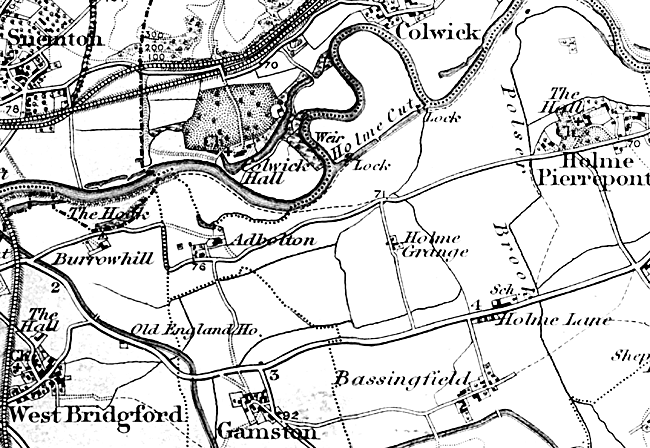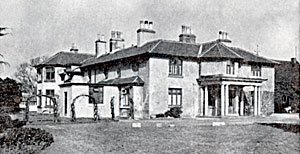Adbolton
Liability to flooding
ADBOLTON arose out of the marshes as alluvial land when the waters drained off and the Trent carved out a changeful course for itself through the valley to which it gave its name. A deserted bed of the river shows that it once flowed where buildings and gardens now exist. The name of the village comes from a Saxon named Ealdbeald, whose "ton"or farm it was, but the first "l" was gradually eliminated, and by the 14th century it was known as Adbolton. It had a church in Danish times, a building almost certainly of timber and consisting of a nave and chancel, probably small, for the parish has ever been one of the smallest and least populous in the shires.

Adbolton and its surroundings in the 1880s.
At the Conquest its manor was held byGodric the priest and was taxed to the geld at 10s., but twenty years later it was part of the huge possessions of WilliamPeverel, and it was obviously prospering, for its taxable value had increased twofold. It comprised six bovates of land—each bovate being as much as an ox could plough in a year —and 7a. of valuable meadow. There were six villeins (men not permitted to quit the manor) and one bordar (or serf), who were under the supervision of the reeve of one of Peverel's many other manors.
Some idea of the diminutive size of this parish is afforded by the fact that its Pentecostal offerings at Southwell amounted to only 3¼d. a year, quite the least contribution from any place and but one fifth of the average amount.
In 1154, when Henry II ascended the throne, the Peverel of that time fled and is said to have taken the cowl to avoid the king's vengeance, and the Strelleys began their long ownership. They held the manor from the Crown by service of finding a falcon for the sport of hawking, but later this was altered and the tenure became payment of twelve crossbows yearly, but only if asked for. The new owners nearly lost their estates through Robert de Strelley's adherence to Simon de Montfort in the baronial war in the 13th century, Robert having the misfortune to be captured at Kenilworth. He was imprisoned and his estates were forfeited, but in the following year (1267) he was pardoned and restored to his possessions upon payment of a fine but the lord of Adbolton had the satisfaction of knowing that he had helped to establish Parliament.
Sixty years later, in 1316, a John Bully (or Busli) was sued by a Nottingham merchant for improperly arresting his boats here. One was outward bound with corn for transhipment at Gainsborough, and another was bringing merchandise to the town, but the result of the action, in which an overdue debt was concerned, is not recorded. There may have been a little landing-stage here, but it requires some imagination to conceive of Adbolton as a riverside port, however tiny.
Long series of law suits
By the marriage of two Strelley heiresses in the time of Edward I much of the village passed to the Elands and to the Basilys of Radcliffe, but the manor remained with its old owners. It will be remembered that it was a William Eland, deputy governor of Nottingham Castle, who guided, supporters of the youthful Edward III by secret ways to the chamber where the queen-mother Isabella, was captured with Roger Mortimer in 1330. thus enabling that monarch to. begin to reign. Gradually the Elands fell on evil days, and their patrimony diminished to small parcels of land here and at Bridgford. and when Henry Eland died in 1493 his heir was a baby girl. Her interests may have been acquired by John Williamson, who died in 1529, but fresh families were obtaining land, and owing, at least in part, to the uncertain state of the laws affecting property, a long series of claims and suits had set in and continued for generations. The Elands sued the Williamsons, who were also claimed against by the Revells; the Pierrepoints sued the Sotehills. and in. the reign of Henry VIII the Eland heiress, then widow of Roland Revell, sued Sir Nicholas Strelley for detention of deeds. That quarrelsome knight entered a cross-action against her, but the lady won, and at her death she left her estate to her cousin Revell, "because he had helped her in her great suits against Sir Nicholas Strelley".
Suits and claims continued, but presently the Eland properties passed to Sir Nicholas Byron, from whom they went to the Halls, who did not long enjoy them. In 1598 the last Strelley link was broken when Queen Elizabeth granted the manor house and lands to Sir Henry Pierrepoint, with whose descendants they have ever since remained. The lawsuits still persisted, the Earl of Shrewsbury, John Harper, Francis Hall, Sir Henry's widow, and Elizabeth Gisborne being litigants, and a Jane Gisborne vainly strove to revive an Eland claim.
Apart from this chequered descent of lands and rents, the annals of the village during the 16th and 17th centuries relate chiefly to matters of religion. When the Church of England was established in 1559, it was found that the church was closed and there had been no worship there for two years. In 1624 William Allen, of Adbolton, was arrested for "keepinge a writinge schoole in the parishe of St. Maryes of Nottingham, for that he is a Recusant." Under the Commonwealth, Adbolton was united with Holme Pierrepoint for register purposes, and its Puritan minister, Thomas Leeke, was receiving £20 a year, but with the Restoration trouble with Dissent set in. Upon the passing of the Act of Uniformity in 1662, the Presbyterian Thomas Rose declined to conform and was ejected from that living. After undergoing six months' imprisonment for preaching, he settled here; perhaps he descended from that Alderman Rose of Nottingham who, in 1528, had bequeathed 30s, to Adbolton Church. Defying the attentions of the Southwell prebendaries, he ministered here at Bridgford, Gamston, and elsewhere, assisted by the Rev. John Leighton, who had been ejected from Linby, and, taking advantage of the Declaration of Indulgence, 1672, he obtained licence to preach in his cottage. Within a year the Declaration was withdrawn, but the two Nonconformists ignored the law and continued their labours, their little conventicle being heavily fined. In 1683 it paid £4, and Justice Charlton accounted for £6 11s. 6d. fines levied by him upon it. In 1685, Rose was imprisoned again, but he resumed his ministrations upon his release, large congregations coming to hear him. He died, excommunicated, very poor, and very lame, in 1698.
Thoroton states that the ecclesiastical parish of West Bridgford extended to Gamston, Bassingfield, and Adbolton, and that by his time (1677) the church, which was formerly a rectory, had been reduced to a vicarage, but he knew not how. The known list of its clergy ends with 1691, when Samuel Birch was instituted to the cure. That the parish was not overcrowded is clear from the church return of 1672 that there were then not more than thirteen inhabitants of age (16) to take the Sacrament, as prescribed by law.
By the early part of the 18th century "the inhabitants and possessors of this town, being sensible of the convenience and safety of inclosures as well as of the profit of them, separated their lands from the common field and fenced them in, "and the physical appearance of Adbolton was changed to its modern form." In 1746 came a further change, for then the church was pulled down. The parish had been annexed to Holme Pierrepoint in 1707; its church was in ruins, and in 1743 the parson reported that "there is now no house or parishioner belonging to it." Its plate was removed to the new mother church, and its material was scattered, some going to repair Holme Pierrepoint church and some was incorporated in farmhouses here and at Gamston. In 1834, when the site was levelled, various human remains and coins were unearthed; some of the gravestones went to make a pavement for an adjoining farm, and so the last traces of All Saints' Church were obliterated. A few years ago a fine pear tree marked its position: no plan or illustration remains to indicate what it was like.

Adbolton Hall in its role as Country Recovery Home belonging to the Nottingham Hospital for Women, c.1950.
Floods have ever been destructive here, and must have made communications difficult. In 1634, the way between Adbolton and Gamston was reported to the magistrates for its evil state; it degenerated into an accommodation lane and now survives as a footpath. So recently as the reign of George V Adbolton was still described as a hamlet, but to-day it would be more accurate to call it a developing suburb of the overgrown urban district of West Bridgford.
